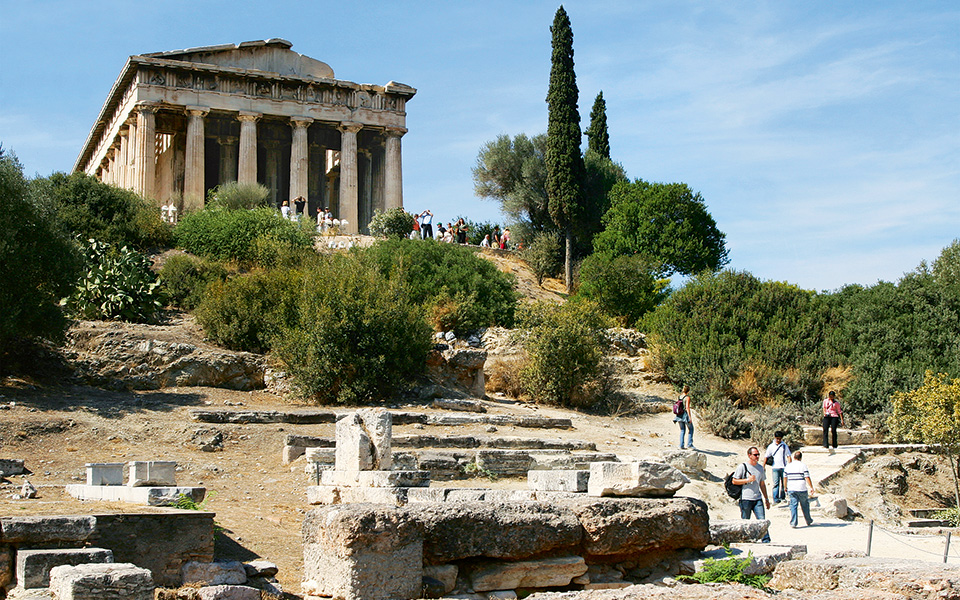Visitors to Athens seeking to whet an appetite for Greece’s fascinating, universally influential ancient past have much to choose from these days, given all the unique archaeological sites, scenic historic spots and impressively refreshed museum galleries now available around the city.
Chalking up memorable experiences is really what exploring Athens is all about and the city holds many surprises, even in places where you thought you already knew what to expect—ranging from hilltop ruins, to towering, Redwood-like columns, to a major ancient shipwreck in the midst of Athens’ bustling modern cityscape.
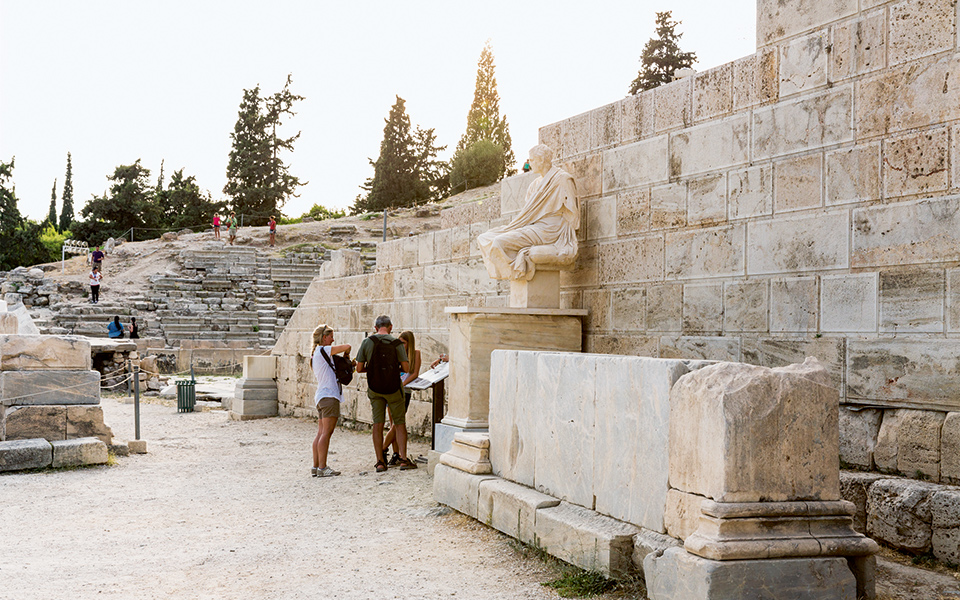
© Dionysis Kouris
THE ACROPOLIS
• Opening hours: Daily 08.00-20.00
• Admission: Full € 12, Reduced € 6
• This ticket allows admission to all main archaeological sites, seven days a week.
• Tel.: (+30) 210.321.4172
At the top of the list is the Acropolis: one always begins with a pilgrimage to the greatest marble temple ever built or to have survived the turbulent centuries since antiquity. But don’t make a beeline for the Parthenon and miss all the other intriguing details to be noted during your ascent or hilltop walkabout.
The Theater of Dionysus and the stone arches of the Odeon of Herodes Atticus lie along your path, as you tread up the south slopes in the footsteps of likely every famous ancient Athenian to have left their mark on the city’s cultural and political history.
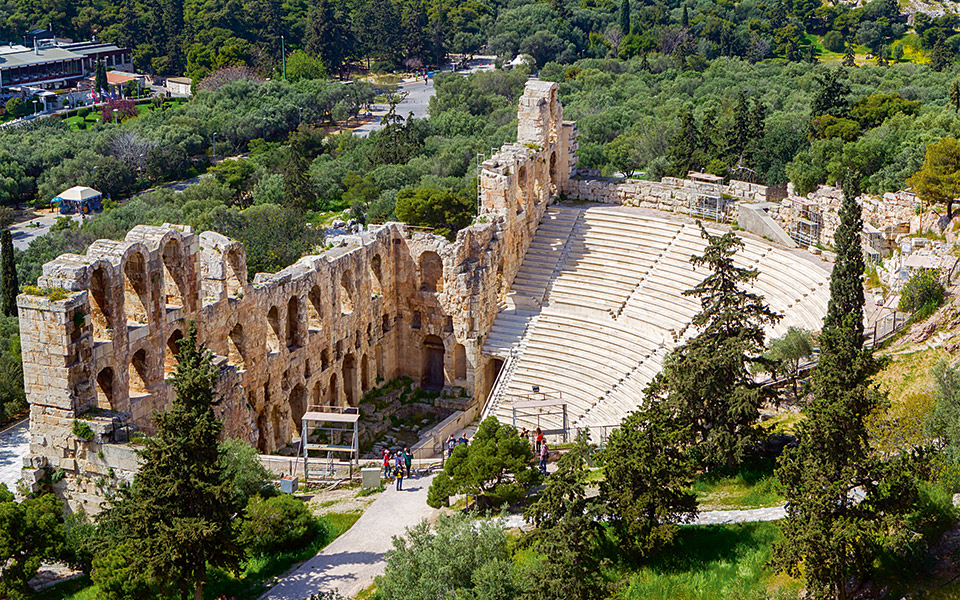
© Shutterstock
Beginning some 2,500 years ago, this was an area of Athens frequented by playwrights, city leaders, social critics, would-be brides and many other local inhabitants or visitors seeking musical entertainment, drama, hilarity, religious fulfillment or medical relief. The small Sanctuary of Asclepius, once something of a hospice or health clinic, reminds us of the terrible plague that swept through the walled-in, war-torn city and claimed the life of its great leader Pericles in 429 BC.
As you climb higher, catch a second glimpse of the Odeon from above, with its tiers of marble seats: a benefaction to the city made in the name of Regilla, Herodes’ wife — herself a great public benefactress and the head priestess of Tyche’s temple, whose ruins lie hidden on the wooded knoll beside the horseshoe-shaped Panathenaic Stadium, easily distinguishable from the Acropolis.
“ The Odeon of Herodes Atticus was a benefaction to the city made in the name of Regilla, Herod’s wife, herself a great benefactress and head priestess of Tyche’s temple. ”
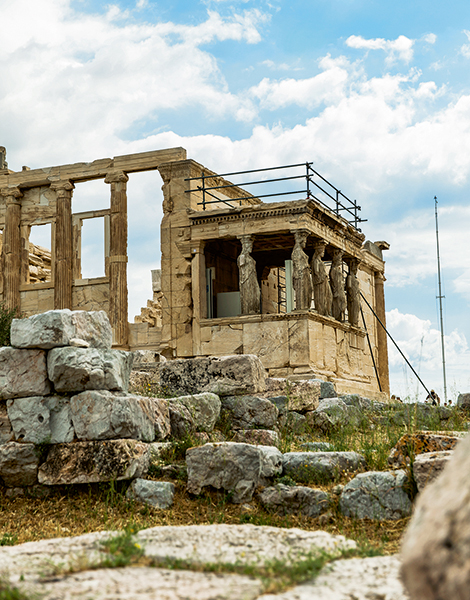
© Dimitris Vlaikos
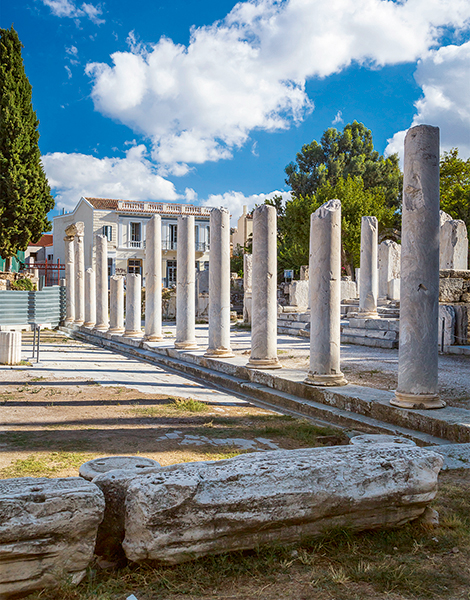
© VisualHellas.gr
“ Both the Propylaia and the Athena Nike temple have been newly restored by the Acropolis’ modern team of architects, engineers, conservators, and traditional stonemasons. ”
Passing upward through the Propylaia, be sure to check out its coffered ceiling and the exquisite Ionic styling of the Athena Nike temple on the right, both newly restored by the Acropolis’ modern team of cutting-edge architects, engineers, conservators and traditional stonemasons.
On emerging from the colonnaded gateway, you have before you the jewels of the Sacred Rock: the Parthenon with its highly refined Doric architecture; the Erechtheion with its elegant Caryatids and moldings; and, from the Belvedere, one of the best panoramic views of age-old Athens and its surrounding hills.
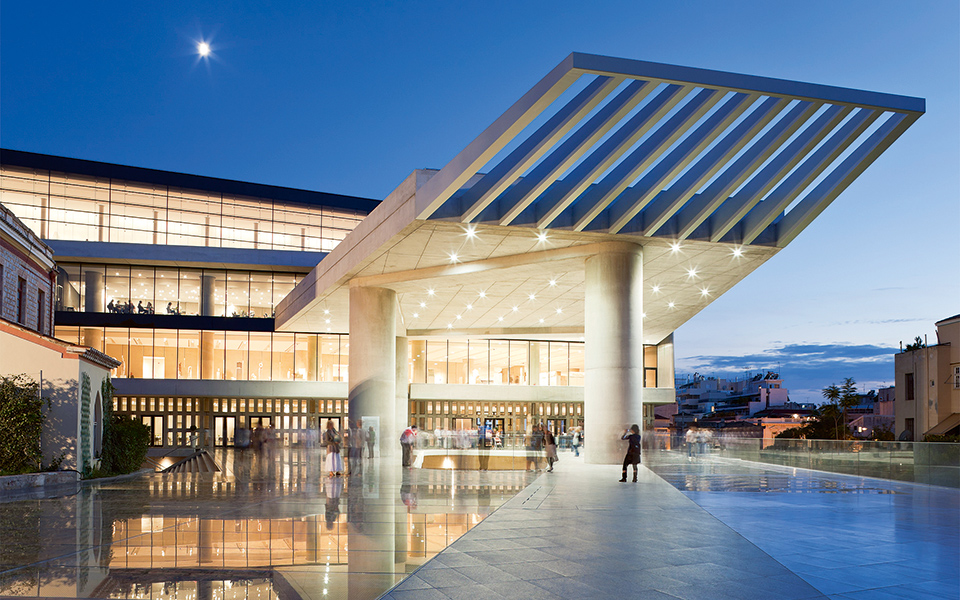
© Katerina Kampiti
Equally impressive experiences can be had at lower altitudes all around the Acropolis, especially at the new Acropolis Museum. Here also the small details hold the key, from scenes of women’s rituals and everyday life painted on Classical vases, to traces of once-bright paint on Archaic Kore (maiden) statues, to the remarkably intricate carving of the Parthenon’s frieze and metopes — in a top-floor gallery whose northern all-glass walls frame the Acropolis as an added bonus to the museum’s already superb exhibits.
West of the Acropolis is the Hill of the Muses, whose summit offers another inspiring view of the Rock with its temples and especially of the blue Saronic Gulf and Piraeus, home to ancient Athens’ triple-basined military-commercial port. Adjacent is the Pnyx Hill that still retains the speakers’ rostrum and hillside auditorium of the popular assembly (Ekklesia), once echoing with the speeches of Pericles and Demosthenes.
ACROPOLIS MUSEUM
15 Dionysiou Areopagitou
• Tel.: (+30) 210.900.0900
• Opening hours: April 1 – October 31: Monday 08.00-16.00; Tuesday-Sunday 08.00-20.00; Friday 08.00-22.00 November 1 – March 31: Monday-Thursday 09.00-17.00; Friday 09.00-22.00; Saturday & Sunday 09.00-20.00
• Admission: € 5, Last admission is half an hour before closing.
• www.theacropolismuseum.gr
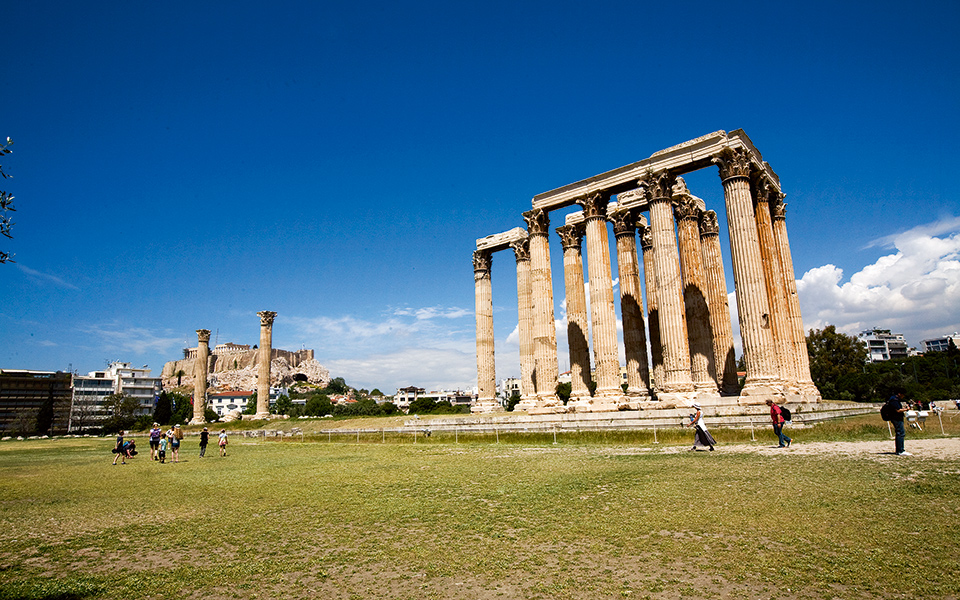
INFO
ATHENIAN AGORA & MUSEUM
24 Adrianou
• Tel.: (+30) 210.321.0185
• Opening hours: Daily 08.00-20.00
• Admission: Full € 4, Reduced € 2
Includes admission to all the main archaeological sites in the historical center.
OLYMPEION
Entrance from Vassileos Olgas Av.
• Tel.: (+30) 210.922.6330
• Opening hours: Daily 08.00-20.00
• Admission: Full € 2, Reduced € 1
On the north side of the Acropolis, in the Athenian Agora, the ancient city’s main public square, one can almost feel the presence of Socrates, philosophizing to the city’s youth in the House of Simon the Shoemaker, or of Thespis, the world’s first award-winning actor who performed along the Agora’s lanes. The temple of Hephaestus and Athena (Hephaisteion), the best-preserved temple of ancient Greece, also deserves a look, while the Stoa of Attalos and its museum packed with objects evoking daily life and the ways of democracy in ancient Athens should not be missed.
To the east of the Acropolis, as you wander through Plaka, the solitary marble Lysicrates Monument stands sentinel not only to the past tradition of wealthy sponsors (choregoi) displaying their victory prize from a theatrical contest, but also calls to mind Lord Byron, who once used this diminutive monument’s internal space as a study — in the early 19th century when a Capuchin convent had grown up around the 4th century BC structure and rented rooms to visitors.
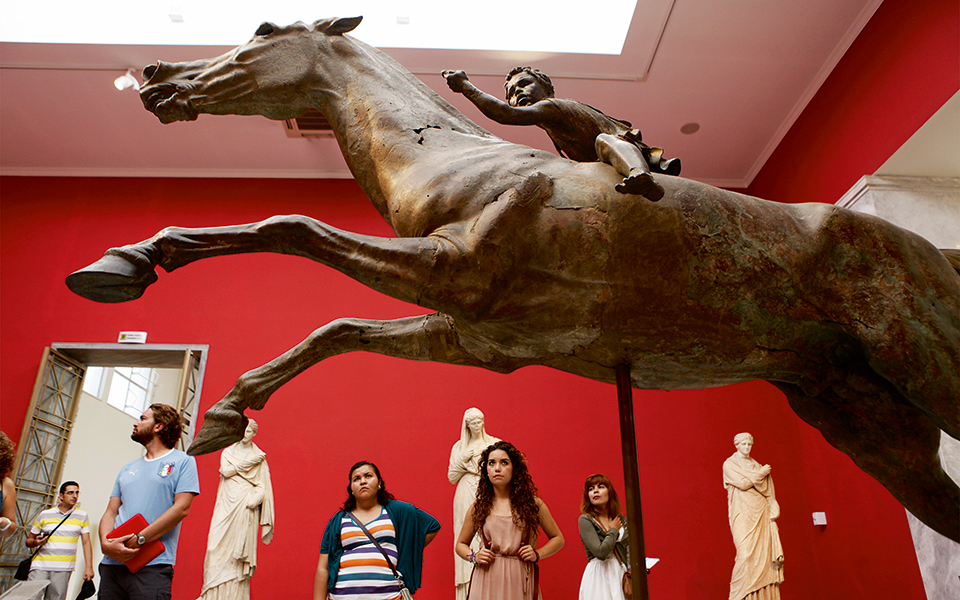
© Katerina Kampiti
Further east stand the massive Corinthian columns of the Olympieion, beside which one feels dwarfed in the shadow of such an enormous, ambitious building project. As recently as the mid-19th century, a seclusion-seeking monk carrying on the ancient stylite tradition made his home atop the columns and had his daily sustenance raised to him in a basket.
Among Athens’ most notable museums, including the Byzantine and Christian Museum with its 30,000 works of art that compose an impressive panorama of the Byzantine and Post-Byzantine cultural heritage in the Hellenic territory, is the crowning National Archaeological Museum, where you can have a personal audience with such prototypical works of art as the handsome Zeus/Poseidon, the “Boxing Boys of Akrotiri,” the bemused Aphrodite slapping at Pan and the gleaming “Antikythera Youth” with his arresting inlaid eyes. This last figure stands within the unparalleled “Antikythera Wreck” exhibition, where you’ll also find strangely encrusted statuary; remains of the wooden ship itself and its equipment; and the strikingly sophisticated Antikythera Mechanism, the world’s oldest computer.
INFO
BYZANTINE & CHRISTIAN MUSEUM
22 Vassileos Sofias
• Tel.: (+30) 213.213.9572,
(+30) 213.213.9500
• Opening hours: Daily 08.00-20.00
• Admission: € 4
NATIONAL ARCHAELOGICAL MUSEUM
44 Patission
• Tel.: (+30) 213.214.4800
• Opening hours from April 1, 2015: Daily 08.00-20.00
• Admission: € 7

